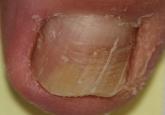Original Research
Efinaconazole Solution 10%: Topical Antifungal Therapy for Toenail Onychomycosis
Toenail onychomycosis is a common disease with limited treatment options, as treatment failures and relapses frequently are encountered. Many...
Shamanth Adekhandi, MSc; Shekhar Pal, MD; Neelam Sharma, MD; Deepak Juyal, MSc; Munesh Sharma, MSc; Deepak Dimri, MD
From Veer Chandra Singh Garhwali Government Medical Sciences and Research Institute, Srinagar Garhwal, Uttarakhand, India. Mr. Adekhandi, Dr. Pal, Dr. Sharma, Mr. Juyal, and Mr. Sharma are from the Department of Microbiology and Immunology. Dr. Dimri is from the Department of Dermatology.
The authors report no conflict of interest.
Correspondence: Shamanth Adekhandi, MSc, Department of Microbiology, Post Graduate Institute of Medical Education and Research, Chandigarh, India (shamanth.adekhandi@gmail.com).

Results
Of 134 clinically suspected cases of onychomycosis, 78 (58.2%) were from fingernails and 56 (41.8%) from toenails. Clinical diagnosis was confirmed in 96 (71.6%) cases by both fungal culture and direct microscopy but was confirmed by direct microscopy alone in only 76 (56.7%) cases. False-negative results were found in 23.9% (32/134) of participants with direct microscopy and 9.0% (12/134) with fungal cultures. The results of direct microscopy and fungal culture are outlined in Table 1. The study included 78 (58.2%) males and 56 (41.8%) females with a mean age of 44 years. Highest prevalence (47.8%) was seen in participants older than 40 years and lowest prevalence (11.9%) in participants younger than 20 years. In total, 32.8% of participants were farmers, 31.3% were housewives, 14.9% were students, and 20.9% performed other occupations. Disease history at the time of first presentation varied from 1 month to more than 2 years; 33.6% of participants had a 1- to 6-month history of disease, while only 3.7% had a disease history of less than 1 month at presentation. The demographic data are further outlined in Table 2.
Distal lateral subungual onychomycosis was the most prevalent clinical pattern found in 66 (49.3%) participants; fungal isolates were found in 60 of these participants. The next most prevalent clinical pattern was PSO, which was found in 34 (25.4%) participants, 12 showing fungal growth. A clinical pattern of CO was noted in 28 (20.9%) participants, 22 showing fungal growth; WSO was noted in 10 (7.5%) participants, 2 showing fungal growth.
Of 96 culture-positive cases, dermatophytes were the most common pathogens isolated in 56 (58.3%) participants, followed by Candida species in 28 (29.2%) participants. Nondermatophyte molds were isolated in 12 (12.5%) participants. The various dermatophytes, Candida species, and nondermatophyte molds that were isolated on fungal culture are outlined in Table 3. Of the 96 participants with positive fungal cultures, 30 (31.2%) were farmers working with soil, 28 (29.2%) were housewives associated with wet work, 16 (16.7%) were students associated with increased physical exercise from extracurricular activity, and 22 (22.9%) were in other occupations (Table 4).
Toenail onychomycosis is a common disease with limited treatment options, as treatment failures and relapses frequently are encountered. Many...

Onychomycosis is a fungal infection of the nail plate by dermatophytes, yeasts, and nondermatophyte molds.

In summer 2014, the US Food and Drug Administration (FDA) approved 2 new topical medications for onychomycosis. In recent months, the Journal...
